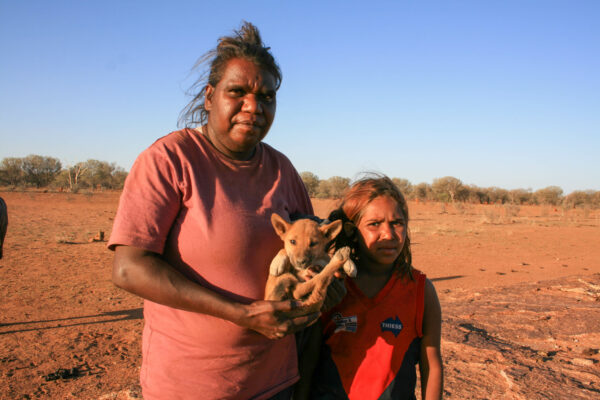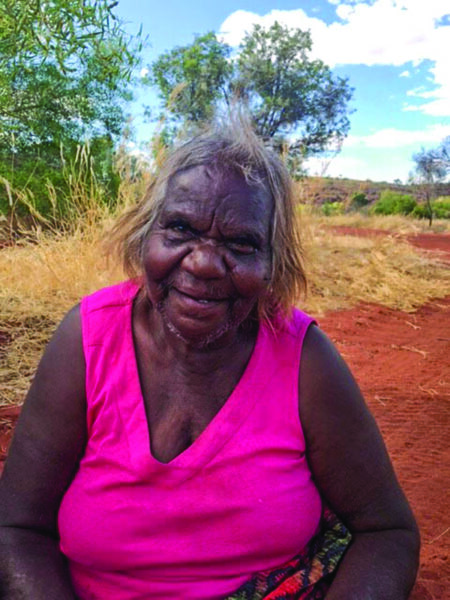
Enid Gallagher leaned forward over the spinifex and clutched her chest in fear. Suddenly, she wasn’t just showing the three young men from Nyirrpi how to track brush-tailed mulgara, she had become the frightened animal.
The animal in question is a small, threatened marsupial Yapa call jajina.
“Jajina wake at night when the lightning strikes,” she said, and pointed to the burrow beneath the spinifex.
Her teenage students learn the difference between fresh and old kuna (poo) left by the small marsupial, and read the tiny footprints around their burrows.
They listened carefully to their kuyu pungu (master tracker), and filled out their work sheets.
Reading and learning the country (yitaki mani) is part of a workshop by eight senior Yapa knowledge holders, educators, Central Land Council rangers from Yuendumu, Nyirrpi and Willowra and other staff.
The week-long workshop at the Newhaven Wildlife Sanctuary, 363 kilometres northwest of Alice Springs, included Nyirrpi high school students so they could road-test new learning materials developed by the Yitaki Mani project working group.
The workshop is part of a new CLC project that aims to find out how senior Yapa knowledge holders pass on a lifetime of learning and caring for country to Yapa who grew up in settlements.
Unlike young people today, kuyu pungu and Warlpiri Ranger Alice Henwood was born out bush, west of Nyirrpi, and learned to live off the land. “I’m one of the last bush ladies,” Ms Henwood said proudly.

Now in her sixties, she learned to track as soon as she could walk and follow her parents and aunties on the hunt.
Ms Henwood’s journey took many years, but she feels a sense of urgency to teach her young colleagues.
“I am worried that when I pass away that knowledge will just disappear. That’s why we have to pass the knowledge to the young rangers now, as well as the young people, so they can pass on to their kids,” she said.
“I am worried that when I pass away that knowledge will just disappear. That’s why we have to pass the knowledge to the young rangers now, as well as the young people, so they can pass on to their kids,” she said.
Warlpiri Ranger Alice Henwood, one of the last people to grow up living off the land.
Yapa and the CLC want to fast-track that learning process so that young rangers have access to yitaki maningjaku – everything you need to know to track.
The project working group developed teaching and learning materials that young people can relate to, but that still foreground Yapa knowledge systems.
Kardiya (non-Aboriginal people) typically trap animals to identify what species live in an area, but this only works if something falls into the trap.
A skilled kuyu pungu, however, can tell you the size, diet, territory and hunting patterns, as well as the speed of travel, age and sex of all the animals, reptiles and insects that left tracks around the trap overnight.
“We teach whitefellas, and we also learn from them too,” said Ms Henwood’s daughter and fellow Warlpiri Ranger Christine Michaels.
“Like with the tablets CLC showed us how to store information about endangered animals.”
Yapa knowledge is not just about identifying the animal, it’s also about the purda nyanyi (sensory awareness) of the expert tracker, which is traditionally stored in their head.
Thanks to funding from the 10 Deserts Project, the Yitaki Mani team is developing tools and resources to maintain and promote this knowledge for generations to come.
“I’m getting a little bit sick now, so I really need to pass my knowledge to the younger rangers and the kids.
I’ve been working for a very long time,” Christine Michaels said. “Today the kids from Nyirrpi were really excited to go tracking for jajina and warrarna (great desert skink) and count the burrows.
I was really happy with that.“If young people want to become a ranger they have to work to know their country, spend time with elders on country, and not go into town drinking,” she said.
